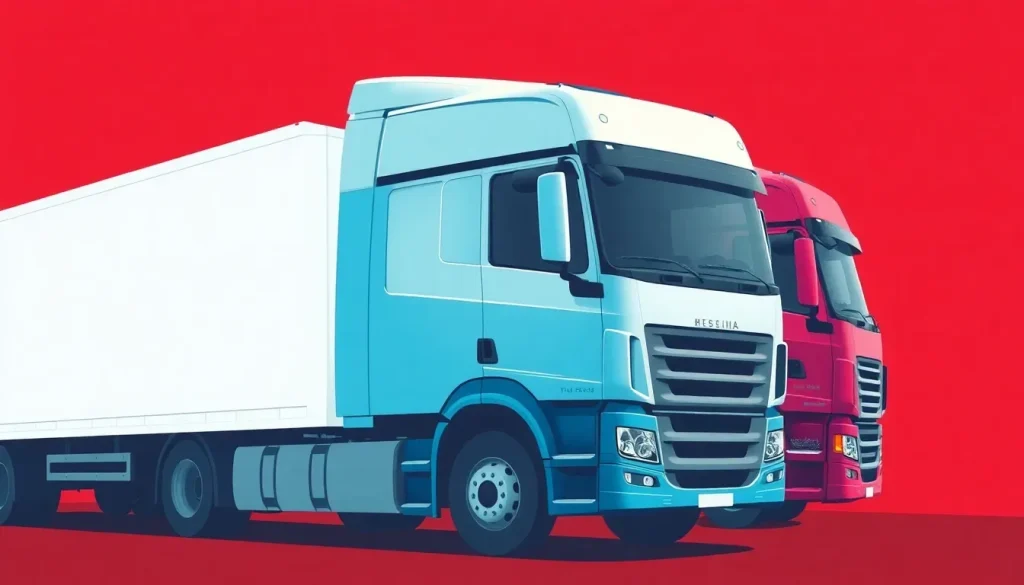Truck registrations decline in October

In an ever-evolving automotive landscape, understanding the dynamics of the commercial vehicle market is crucial for stakeholders. Recent trends highlight both growth and challenges within the sector, reflecting a complex interplay of demand, technological advancements, and economic factors.
This article delves into the latest statistics and expert insights regarding the commercial and industrial vehicle market, showcasing the rise in light commercial vehicles while addressing the stagnation in electrification and the decline in truck registrations.
Market Analysis: Commercial and Industrial Vehicles in October
The commercial vehicle market has seen significant fluctuations recently, with light commercial vehicles demonstrating resilience amidst broader challenges. In October alone, registrations of light commercial vehicles soared by 8.5%, reaching a total of 16,668 units. This performance is not just a monthly anomaly but part of a broader trend, with the cumulative total for 2025 standing at 154,837 units, marking an impressive 12.6% increase compared to the previous year.
Breaking down the numbers by segment, rental companies emerged as the key drivers of growth, registering 1,908 units and reflecting a robust 20.5% increase. Additionally, self-employed individuals and businesses also contributed positively, with growth rates of 5.2% and 7.7% respectively. This indicates a healthy demand for commercial vehicles, particularly in urban transportation and logistics.
However, while the light commercial segment thrives, the electrification of this market has encountered significant obstacles. Despite ongoing efforts to promote electric vehicles, over 90% of light commercial vehicles still rely on diesel engines, highlighting a critical gap in the transition towards greener alternatives.
Decline in Heavy Vehicles and Buses After Two Months of Growth
In stark contrast to the light commercial sector, the market for heavy industrial vehicles and buses experienced a downturn in October. Registrations plummeted by 0.5%, totaling 4,630 units. This decline is even more pronounced when looking at year-to-date figures, which show a 6.6% drop compared to the same period last year, with a total of 28,857 units sold.
The industrial segment specifically saw a 1.9% contraction, resulting in 4,206 new registrations. However, buses and coaches bucked the trend, achieving a remarkable growth of 17.1% with 424 units sold. This mixed performance underscores the uneven recovery across vehicle categories and regions.
| Segment | October 2025 | % Change vs 2024 | Jan-Oct 2025 | % Change vs 2024 |
|---|---|---|---|---|
| Light industrial >3.5≤6 Tn | 186 | 264.7% | 833 | 19.2% |
| Medium industrial >6≤16 Tn | 265 | -20.4% | 3,012 | -18.1% |
| Heavy industrial >16 Tn | 3,755 | -3.8% | 21,288 | -6.0% |
| Rigid trucks >16 Tn | 528 | -10.2% | 4,813 | -6.7% |
| Tractors | 3,227 | -2.7% | 16,475 | -5.7% |
| TOTAL Industrial Vehicles | 4,206 | -1.9% | 25,133 | -7.0% |
Top Brands in Heavy Vehicle Registrations
In the competitive landscape of heavy vehicles, several brands have managed to capture significant market share. Below is a summary of the top performers in terms of registrations for the year-to-date:
| Rank | Brand | Rigid Vehicles | Tractors | Total Heavy Vehicles (>16 Tn) | % Change vs 2024 (total) |
|---|---|---|---|---|---|
| 1 | VOLVO | 465 | 3,322 | 3,787 | 1.3% |
| 2 | IVECO | 1,108 | 2,424 | 3,532 | -6.6% |
| 3 | MERCEDES | 724 | 2,336 | 3,060 | -20.7% |
| 4 | RENAULT TRUCKS | 1,064 | 1,948 | 3,012 | -1.0% |
| 5 | DAF | 341 | 2,102 | 2,443 | -2.0% |
| 6 | SCANIA | 389 | 2,340 | 2,729 | -12.8% |
| 7 | MAN | 639 | 1,785 | 2,424 | 8.2% |
| 8 | FORD TRUCKS | 35 | 165 | 200 | -26.7% |
| 9 | BMC | 2 | 53 | 55 | 22.2% |
| 10 | BUXO | 17 | 0 | 17 | 0.0% |
Expectations for the End of 2025
Looking ahead, experts are cautiously optimistic about the overall market trajectory. Félix García, director of Communication and Marketing at ANFAC, noted that the growth trend observed in October reinforces a positive outlook. He anticipates that total car registrations will reach between 1.12 and 1.13 million by the end of 2025, surpassing pre-pandemic levels.
Raúl Morales, spokesperson for FACONAUTO, emphasized the resilience of the national market. The electrification segment has been pivotal in this recovery; however, he cautioned about the scarcity of support in certain autonomous communities, where electric mobility funds have been depleted.
Similarly, Tania Puche from GANVAM highlighted that the market has seen 14 consecutive months of positive growth, yet she stressed the urgency to expand the budgets for the Moves plans to sustain this momentum. She concluded that losing traction at this critical juncture would be detrimental to the ongoing recovery.
Factors such as rising energy costs, insufficient incentives for electrification, and slow fleet renewal have weighed heavily on overall figures. Nonetheless, the industry remains hopeful for improved conditions as internal demand continues to rise.
For more insights and updates, stay connected with us on our social media channels: Facebook, Instagram, and YouTube.
To further explore how the commercial vehicle market is evolving, watch this insightful video:




Leave a Reply